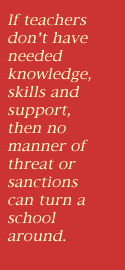
Table of Contents:
Can State Intervention Spur Academic Turnaround?
Worst Case: When Takeover Happens
Closing the Professional Learning Gap
Printing this page? Follow this link to a printer-friendly version.
Closing the Professional Learning Gap
For student achievement to improve, an intervention strategy must focus strongly on capacity building. The following should be taken into account:
 Policymakers
tend to underestimate how much guidance and information teachers need
to become familiar with new standards, assessments and administration
requirements; to understand how new forms of assessments are developed
and scored; to examine and evaluate students’ work under the standards;
and to acquire enough information and pedagogical knowledge to change
their practices. (8)
With the exception of a few— notably Vermont and Kentucky—
states have been slow to support ongoing professional development. Yet
falling short on teacher capacity building almost certainly limits improvement.
Some states seem to assume that accountability and incentives will prompt
school districts to supply adequate teacher support. But in many districts
resources for new materials or professional development do not exist.
Policymakers
tend to underestimate how much guidance and information teachers need
to become familiar with new standards, assessments and administration
requirements; to understand how new forms of assessments are developed
and scored; to examine and evaluate students’ work under the standards;
and to acquire enough information and pedagogical knowledge to change
their practices. (8)
With the exception of a few— notably Vermont and Kentucky—
states have been slow to support ongoing professional development. Yet
falling short on teacher capacity building almost certainly limits improvement.
Some states seem to assume that accountability and incentives will prompt
school districts to supply adequate teacher support. But in many districts
resources for new materials or professional development do not exist.
- Administrator development is critical. Confirming the experience of many others, Oregon State Superintendent Norma Paulus says it was "a big mistake" when her state did teacher— but not administrator— staff development. Teachers only met with frustration when they tried to apply new approaches in school environments that blocked their efforts. What’s needed are changes in the professional culture of schools. Administrators need support to become strategic thinkers who can organize a school to be results-oriented and play a supportive role as staff work through a continuous improvement process. Teachers need help to learn how to work together, become integral members of decision-making teams and use data for decision making.
- Readily-available, whole-school restructuring programs can help. The best involve extensive and ongoing professional development that helps teachers deal with classroom instruction and have clear goals that are well-matched to schools’ goals. (9) Programs such as Success For All, the Comer School Development Profram and Accelerated Schools have been found effective in educating low-income and minority students. (10)
- Universities can play a central role. In California, for example, new collaborations between teacher preparation colleges, school districts and county offices of education have resulted from the emergency created when thousands of inexperienced—often uncredentialed—teachers were hired under the state’s 1996 class size reduction initiative. In Cincinnati, Ohio, a five-year partnership among the public schools, the University of Cincinnati and the teacher union has produced a program that links teacher education with student performance. The university’s redesigned education program requires a major in the subject candidates will teach and practical experience in one of 11’s new Professional Practice Schools. (11)
- State department staff need support. State departments of education, key partners in school turnaround, need to build their own capacity to help the staffs of low-performing schools or districts. State department staff may offer direct assistance. Or they may coordinate expertise from a variety of sources that can support schools in trying new approaches, making rational and informed choices among proven or promising programs and then continually assessing and improving the quality of those programs. Either way, they continually need ways to link with the best knowledge from research and practice.